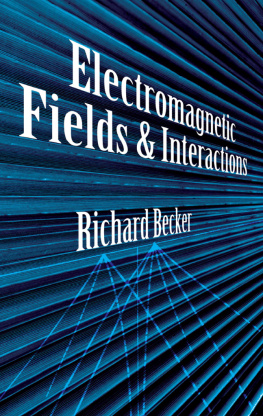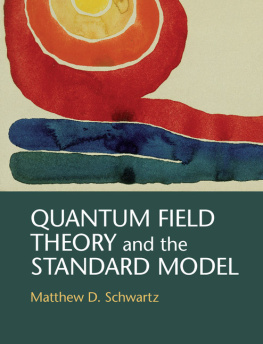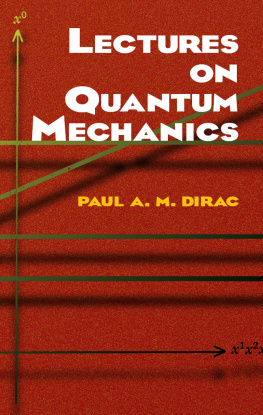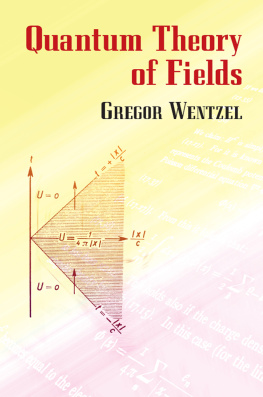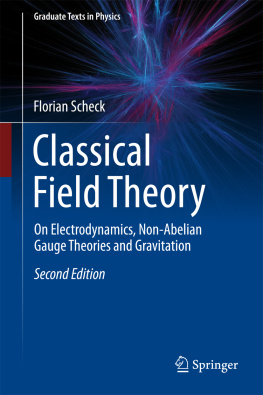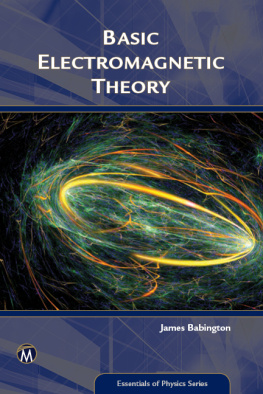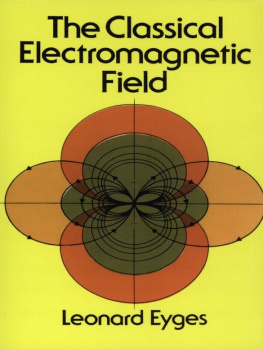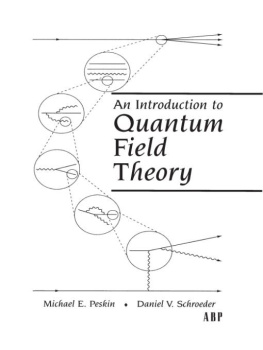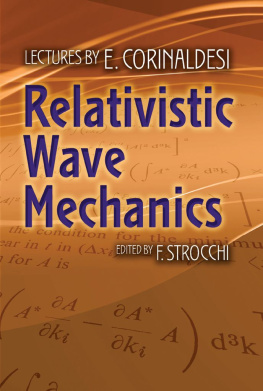ELECTROMAGNETIC FIELDS AND INTERACTIONS
RICHARD BECKER
EDITED BY PROFESSOR FRITZ SAUTER PH.D UNIVERSITY OF COLOGNE
DOVER PUBLICATIONS, INC.
MINEOLA, NEW YORK
Copyright 1964 by Blaisdell Publishing Company and Blackie and Son Limited.
All rights reserved
This Dover edition, first published in 1982 and reissued in 2012, is an unabridged republication in one volume of the work originally published in two volumes in 1964 by Blaisdell Publishing Company, N.Y., simultaneously with Blackie and Son Limited, Glasgow. This is the only authorized translation of the original German Theorie der Elektrizitt, published by the B. G. Teubner Verlagsgesellschaft, Stuttgart. The present edition is published by special arrangement with Blackie and Son Limited.
Library of Congress Cataloging in Publication Data
Becker, Richard, 1887-1955.
Electromagnetic fields and interactions.
Translation of: Theorie der Elektrizitt.
Reprint. Originally published: New York : Blaisdell Pub. Co., c1964. (A Blaisdell book in the pure and applied sciences).
Includes indexes.
Contents: v. 1. Electromagnetic theory and relativity v. 2. Quantum theory of atoms and radiation / translated by Ivor de Teisser ; rev. by Gnther Leibfried and Wilhelm Brenig.
1. Electromagnetic fields. 2. Relativity (Physics) 3. Electrons. 4. Quantum theory. I. Sauter, Fritz, 1906- . II. Title. III. Series: Blaisdell book in the pure and applied sciences
QC665.E4B413 198230.14181-19451
ISBN-13: 978-0-486-64290-1AACR2
ISBN-10: 0-486-64290-9
Manufactured in the United States by Courier Corporation
64290908
www.doverpublications.com
VOLUME I
Electromagnetic Theory and Relativity
FOREWORD
August Fppls Introduction to Maxwells Theory appeared in the year 1894. A completely revised second edition followed ten years later, this being the first volume of Max Abrahams Theory of Electricity. This, in turn, was followed a year later by a second volume on the electron theory. From the year 1930 onward, with the appearance of the eighth edition, Richard Becker took over the further editing of the work which, in succeeding years, underwent several basic changes.
With the sixteenth edition of the first volume and the eighth edition of the second, a thorough-going revision of the work, combined with an expansion to three volumes was planned by Becker. His sudden death, however, took him from the midst of his labours on this new revision.
In carrying on the work it was evident to me that Beckers plan should be continued. In remodellingparticularly in the first volume there were many places in the previous first volume (Maxwell theory) and in the previous second volume (relativity theory) which were taken over practically unchanged. On the one hand, so as not to allow the new first volume to become too bulky, it was necessary in places to condense further and to make changeson the other hand, however, it appeared necessary to write certain sections anew or to put them into a new form. Examples here are the sections on dipoles and quadrupoles and their radiation fields, and also the section on the forces on dipoles and quadrupoles in external fields. The sections on the energy relations and force effects in static fields were basically transformed, and with this in particular the Lorentz force, as an experimental formula, was placed at the forefront of the proceedings concerning force effects in the magnetic field.
As previously, so in the remodelling, the Gaussian CGS system of units is used. In remarks appended to certain sections, however, the more important formulae have been transcribed to the Giorgi MKSA system. In this way I hope to have suited in some measure the wishes of both physicists and engineers. The reason for preferring the Gaussian system to the volt-ampere system (which is employed more in practice) is that in the use of the first-mentioned system the formulae of both relativity theory and quantum mechanics can be written appreciably more simply. Moreoever, if the Giorgi system had been employed, the beautiful symmetry between the electric and magneticfield quantities in the four-dimensional Minkowski formalism of special relativity would no longer be so evident.
I have attempted to bring out clearly the mutual relationship of the two measure systems. The transition from the four basic units of the MKSA systemunits which at first sight seem to appear naturally to the three basic units of the Gaussian CGS system, requires that Coulombs law be not only considered as an experimental law, but that at the same time it be regarded as the defining equation for the unit of charge in the Gaussian system. This is because the resulting constant of proportionality, having the dimensions of force times length squared, divided by charge squared, is arbitrarily assumed to be dimensionless and equal to 1. This procedure, violently criticized by certain advocates of the MKSA system, corresponds exactly with todays custom in high-energy physics of combining the length and time dimensions with one another through the arbitrary assumption that the velocity of light in a vacuum is dimensionless and equal to 1.
Since, in the following, the equations of electrodynamics are on the one hand to be understood as quantity equations and not as relationships between the numerical values of physical quantities in special units, and since on the other hand these equations are transcribed part by part in different ways in the two unit systems employed here, only a few of all the symbols employed represent the same physical quantity in both measure systems. Examples are the symbols of kinematic and dynamic quantities, and of electric charge, electric polarization, and electric field strength. In opposition to this (though a fact often overlooked) the symbols of electric displacement as well as those of total magnetic-field quantities, have different meanings in the two systems. Table 6 gives a ummary of the relationships between such quantities customarily described by the same symbol, and it also gives the conversion factors between them. I hope that by means of this table, and also through the presentation of the corresponding relationships in the text, my readersand in particular those who are studentswill be helped through the customarily troublesome process of going over from one unit system to the other.
The translation is the work of Mr. A. W. Knudsen.
F. SAUTER
C OLOGNE , 1964
CONTENTS
A
Introduction
to
vector
and
tensor
calculus
CHAPTER A I
Vectors
1. Definition of a vector
The science of electric and magnetic phenomena prior to the appearance of Maxwells theory was based on the concept of action at a distance between bodies which are electrified, magnetized, or traversed by electric currents. Only the ideas of Faraday differed in this respect from those of other physicists in that he conceived all electric and magnetic actions of one body upon another separated from it as the effect of an electric and/or magnetic field existing between the bodies. Although his manner of interpreting and describing the phenomena was basically a mathematical one, Faraday was nevertheless unable to give his interpretation sufficient completeness and freedom from contradiction to have it raised to the rank of a theory. In this, success was first achieved by Maxwell, who gave Faradays ideas rigorous mathematical form and thereby created a theoretical structure which, as a field-action theory, is essentially different in conception from the action-at-a-distance theory.
Maxwell himself formulated his equations in Cartesian coordinates and only incidentally made use of quaternion theory. A general overall view of the interconnection of all formulae is however considerably facilitated by the use of
Next page
